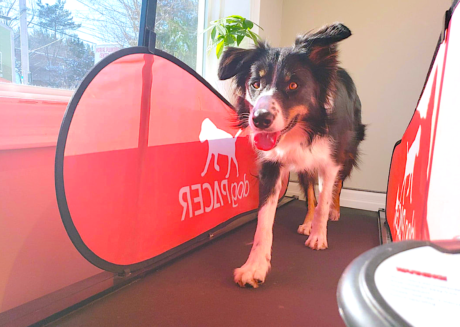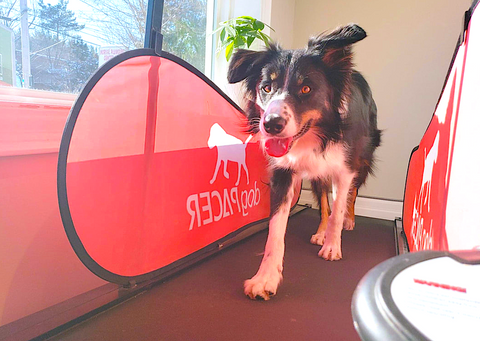

But are treadmills all they’re cracked up to be? What’s the difference between conventional human treadmills and dog-specific treadmills? What exactly do underwater treadmills do that’s different from dry treadmills?
This week I take a deeper dive on treadmills and conditioning – the good, the bad, and the ugly.
Treadmills: Good or Bad?
Pros
- The ability to exercise your dog during inclement weather. With icey winters and less than ideal running surfaces outdoors, the treadmill can be a useful tool to help exercise your dog. There is always a higher tendency for dogs to gain weight over the winter due to reduced exercise and oftentimes, their food intake is not adjusted accordingly. Excess weight is a concern for any dog as it places further stress on joints and tissues.
- An excellent cross-training tool.
- Some dogs really enjoy the treadmill and find it like a trick to master.
Cons
-
The treadmill must be long enough to accommodate your dog.
- It is recommended that the treadmill is at least twice the length of your dog’s body from the front of their chest to the back of their butt, although 3x length is ideal.
-
The treadmill can shorten your dogs’ gait and reduce their reach and drive.
- If your dog feels that they might step off the treadmill, they will shorten their gait long term this is not ideal as it can affect your dog’s movement as they have rehearsed a trot gait with a shortened stride. This means that most human treadmills are not appropriate for your dog to use, especially if you have a large breed dog.
- The treadmill works only one plane of motion.
- Dogs move in three planes of motion and it is important to provide your dog with strengthening exercises that work all three planes of motion. If you exclusively use a treadmill, be sure to supplement it with conditioning exercises that include all three planes of motions to maximize results and strengthen all directions.
- Treadmill placement can affect your dog’s gait
- If the treadmill is facing a wall or other object your dog will tend to shorten their gait thinking that they might run into the object!
- Some dogs find the treadmill boring or stressful – each dog is different!
Underwater treadmills
The premise of the underwater treadmill is that the buoyancy of the water will decrease the effects of gravity and assist with gait training. Water provides resistance that can be increased or decreased manually by raising or lowering the height of water in the tank. This allows dogs to move with a little less effort as their legs float through the water. The buoyancy also takes the weight of their torso off of the elbows, hips, and ankles. This is great for overweight dogs, dogs suffering from osteoarthritis, and dogs with hip or elbow dysplasia. As I’ve said before, movement is medicine, and if underwater treadmill can help keep dogs active I’m all for it.
However, the problem with underwater treadmill comes to a principle known as progressive overloading. In order to build muscle, we need to challenge them by adding progressive resistance. While underwater treadmill will cause some muscle gain there is a limit to how much it can do. Eventually, you’ll hit a plateau. Once you’ve reached that plateau your dog will only maintain their condition and will not continue to strengthen their body. The other issue is if your dog has an abnormal gait. The underwater treadmill will do nothing to fix an abnormal gait and is likely to even build endurance for that gait. Only with the inclusion of other exercises on land can we begin to address and fix that problem!
The big take away here is that underwater treadmill is a conditioning tool which can help dogs with certain conditions but is not necessarily suitable for all clients.
What not to do on a treadmill…
- Never leave a dog unattended on a treadmill!
- Never put your dog in a harness on the treadmill – leashing or harnessing can be dangerous for your dog if they start to get tired and accidentally trip.
- Dogs under 15 to 18 months of age should not participate in treadmill activities due to their age and the potential damage to growth plates.
- Dogs under 10 pounds may have a difficult time on the treadmill because of their short stride length, and using the treadmill could potentially cause damage to their musculoskeletal system.
Things to consider …
Speaking of warm-up – always make sure you warm-up and cool down your dog – expecting your dog to go from the couch to the treadmill without a warm-up is a recipe for injury! When starting progress your dog slowly and always monitor for signs of fatigue – initial treadmill times will very much depend on the current fitness level of your dog – start with 2-3 minutes and slowly build up from there! Make sure your dog is using a trotting gait –this is a rhythmic two-beat gait in which diagonally opposite legs move together (i.e. right hind with left front, left hind with right front). The trotting gait is the most efficient gait and works your dog’s left and right sides evenly. You will also want to vary the speed they work at from a slow trot (jog) to a full out extended trot – this will reduce the chances of them developing an automatic gait that can occur with continued treadmill use
If you have questions, or wonder if the treadmill is a useful conditioning tool for your dog, speak to your health professional.

